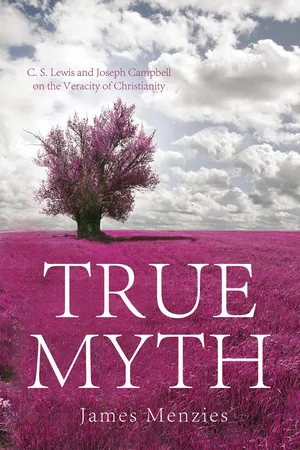![]()
1
Introduction
Need
This book seeks to answer the question “What was the meaning and significance of myth as understood by Joseph Campbell and C. S. Lewis and how did each man apply his understanding of myth to the Christian faith?” In the process of answering this question the Christian faith is represented by certain historical doctrines held by the church since its inception as recorded in the Bible; the central record of the early Christian experience and faith upon which Christian doctrines, traditions, and experiences were subsequently built and therefore central in the interpretations of Campbell and Lewis. Attention is also given to the role of myth in a highly technological society as understood by each author.
A question asked by each generation is “What does it mean to be human in an age of advanced technology?” This book will address the question by exploring not only the thinking of Joseph Campbell and C. S. Lewis regarding myth and religion, but by investigating the influence and presence of myth in philosophy, media, ethics, history, literature, art, music, and religion in a contemporary context. A comparison, analysis, and critique of the perspectives of these two men will enable individuals working in these disciplines to integrate the thoughts of Campbell and Lewis in further reflection upon the relationship between humans and technology in the twenty-first century. For both men, myth held significance, even in a technological society.
Background
Throughout history humanity has pondered matters beyond sensory perceptions. These include hopes, dreams, hunches, intuition, life after death, a realm of “spirituality” and spiritual beings, and even the thought process itself. But because humans often limit certainty to sensory perceptions, assurance about such things remains elusive. And at those rare moments when someone thinks he or she is closest to certainty, where reasoning is able to make sense of existence, such confidence can collapse by a simple change in circumstances. For instance, at the moment a village is convinced how best to please the gods by thinking, “If we offer up our children as a sacrifice the gods will repulse the enemy,” tragedy can strike as an enemy breaks down the walls, invades, and conquers, leaving the people to wonder why the gods remain angry. Individually one may be convinced that his or her act of lust or anger certainly must enrage the “unknown other” but then rewards come. So the question remains: How can I make sense of my existence?
One response to this existential question found throughout primitive and technologically advanced cultures is understanding the role of myth. Throughout human history, myth has served as a source to explain questions of creation and human origins, making sense of tragedy, finding meaning for one’s existence, and to help prepare for life after death. And whether one examines indigenous cultures steeped in religion or highly technological cultures espousing many (or no) religions, there is frequently an evidence of myth handed down through generations resulting in ideas and beliefs that intentionally and unintentionally become part of such cultures and societies.
But as universal as myth is, few words are used with more definitions, or with as many meanings as there are authors to offer them. Following the first entry, from the Westminster Review in 1830, the Oxford English Dictionary has the following definition:
But as traditional and succinct as this definition is, myth appears to be as old as humanity and as profound as the most challenging philosophy.
Further confusing the study are the numerous scholarly writings that each offer their own variation on the term. One dictionary provides the definition,
Professor of philosophy Tom Snyder comments,
While professor of religion Ian Barbour remarks,
And literary theorist and philosopher Roland Barthes writes,
The scope of usage of myth is so vast that it causes New Testament scholar Richard Soulen to admit, “There is, however, no agreed-upon definition, whether in terms of its form (that is, its relationship to fairy tales, sagas, legends, tales, epics, etc.), or in terms of its content and function.” Professor of Philosophy Richard Purtill observes “So much has been written about myth, from all kinds of standpoints, with all kinds of purposes, that the boundaries of the concept of myth have been considerably stretched.” And in the opinion of Old Testament research professor John Oswalt, the thorniest problem in the entire study is how to define myth.
But as Oswalt goes on to point out, the question of definition faces two challenges: “We must first ask whether it is broad enough to include all the items that manifestly share the majority of the common characteristics of the class being defined. Then we must ask whether the definition is narrow enough to exclude those items that only exhibit one or two of the common characteristics. This is a major problem with the definitions of myth.” In exploring the question Oswalt presents two approaches: a historical-philosophical approach and a phenomenological or descriptive approach. He further discusses the semantics and history of the word and concept of myth by writing, “We may further subdivide the historical-philosophical definitions into three groups: the etymological, the sociological, and the literary.”
Purtill also categorizes myths into sections or groups. He points out that to some scholars myth is, first, related to gospel, “which includes but is not confined to the four New Testament accounts.” While Purtill is careful to point out that traditional Christian believers, such as J. R. R....
